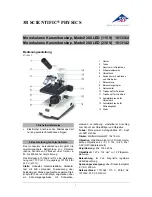
8
2. Setting Up The Instrument
Avoid placing the instrument in locations exposed to direct
sunlight, dust, vibration, high temperature, high humidity and
where it is difficult to unplug the power supply cord.
2.1. Operating environment
• Indoor use
• Altitude: Max 2000 meters
• Ambient temperature: 15°C to 35°C
• Maximum relative humidity: 75% for temperature up to 31°C
decreasing linearly to 50% relative humidity at 40°C
• Supply voltage fluctuations: Not to exceed ±10% of the
normal voltage.
• Pollution degree: 2 (in according with IEC60664)
• Installation / Overvoltage category: 2
(in according with IEC60664)
• Air pressure of 75kPa to 106 kPa
• No hoar frost, dew, percolating water, rain
3. Assembling The Microscope
3.1. Input Voltage
• The automatic voltage selection works with a broad range of
settings. However, always use a power cord that is rated for the
voltage used in your area and that has been approved to meet
local safety standards. Using the wrong power cord could cause
fire or equipment damage.
• In case of using the extension cord, use only a power supply
cord with a protective earth (PE) wire.
• In order to prevent electric shock, always turn the power
switch on the power supply off before connecting the power
cord.
• Electrical Specifications:
a. Halogen
Input : 90-240V~, 80VA, 50-60Hz
Lamp : 6V 30W Halogen
Fuse : 250V T2.5A (If the original fuse is blown, please replace
with specified fuse)
b. LED
Input : 90-240V~, 6W, 50-60Hz
Lamp : 3.4V 3W LED
Fuse : 250V T1A (If the original fuse is blown, please replace
with specified fuse)
3.2. Lamp and Lamp House Cover
(Replacing The Lamp)
The lamp and the lamphouse become very hot during and after
a period of operation.
Risk of burn – Do not touch the lamp during or immediately
after period of operation.
Make sure the lamp has cooled sufficiently before attempting
to replace the lamp.
a. Halogen
• In order to prevent electric shock always turn the power
switch off and unplug the power cord before installing or re-
placing the lamp.
• Place microscope on its back and pull back the lamp house
cover plate.
• Firmly insert the lamp into the socket pinholes until it reach-
es the limit. Be careful not to tilt the lamp when mounting.
• When installing the lamp, do not touch the glass surface of
the lamp with bare fingers. Doing so will cause fingerprints,
grease, etc., to burn onto the lamp surface, reducing the illu-
mination provided by the lamp. If the surface is contaminated,



































